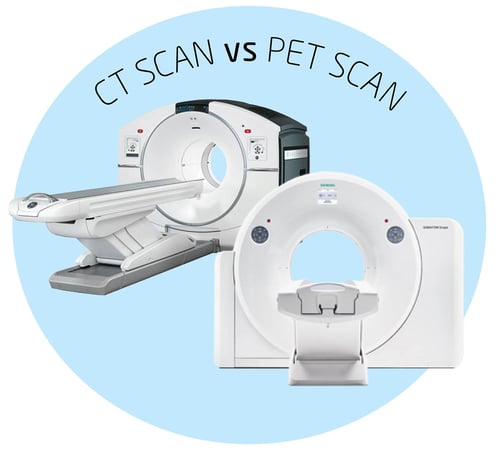More than 80 million CT scans are performed every year in the U.S. and more than 2,086,000 clinical PET scans were  performed in 2,370 hospital and non-hospital sites in 2019. These scans provide a look at the human body’s interior without the need for incisions or invasive procedures. These scans provide physicians with much-needed information so they can determine whether surgery is required, reducing the number of patients going into the surgical suite. Since both PET Scans and CT Scans can provide this information, how are they different from one another?
performed in 2,370 hospital and non-hospital sites in 2019. These scans provide a look at the human body’s interior without the need for incisions or invasive procedures. These scans provide physicians with much-needed information so they can determine whether surgery is required, reducing the number of patients going into the surgical suite. Since both PET Scans and CT Scans can provide this information, how are they different from one another?
What is a PET Scan And How Does it Work?
PET stands for positron emission tomography, a form of Nuclear Medicine Equipment. It’s most often used to detect and monitor cancer or assess brain or heart functioning. The PET scan uses a radiotracer or tiny amount of radioactive material, combined with a camera and a computer. Together, they create images of the inside of the human body which can show a physician how your organs and tissues are working. These scans show doctors how tissues work on a cellular level. Unlike other scanning methods, PET Scans detect diseases in the earliest stages.
PET Scans do take some time to perform. A technologist injects a very small amount of the tracer or radioactive materials into a patient’s vein. It’s usually injected on the inner side of an elbow. The tracer will move through the body to tissues and organs, including tumors, inflamed areas and cancer cells. It usually takes an hour for a body to absorb the tracer material so physicians can see. Then, the patient will be placed on an exam table that slides into the PET Scanner itself. The scanner will collect tracer data which becomes 3-D images on a computer monitor. After a PET Scan, radiation does not stay in the body.
What is a CT Scan And How Does it Work?
CT stands for computed tomography. A CT Scan is an imaging procedure that creates a detailed 3-D image of the inside of a human body. It’s commonly used to check for abnormalities in the neck, spine, brain, abdomen or chest. A CT Scan can provide images of hard tissue like bones and soft tissues like organs and muscles. It’s a great method of seeing a range of images like tumors and broken bones. Doctors can also check for internal bleeding, bone fractures and organ injuries.
CT Scans are quick, easy and painless, making it ideal for physicians to check out life threatening conditions fast, like scanning a patient who has been in an automobile accident. Most hospitals and urgent care facilities have CT Scanners. The patient will be injected with contrast dye or ingest it before a CT Scan. The dye will highlight the area being examined so physicians can see things more clearly. After the CT Scan, small amounts of radiation will remain in the body.
Sometimes, imaging centers will combine PET Scans with CT Scans in order to create more specialized images.
What do PET Scans and CT Scans Have in Common?
PET Scans and CT Scans have several things in common. Both can be used to detect cancer and both eliminate the need for exploratory surgery. They’re both used in an imaging facility or hospital and an overnight stay isn’t necessary. They are both painless, accurate and noninvasive procedures.
Talk To An Expert
If you are in the market for a PET Scanner or CT Scanner, oftentimes a used or refurbished one can provide the performance you need and the warranties you want. Atlantis Worldwide has been helping hospitals, clinics, urgent care facilities and other medical operations find the ideal medical imaging equipment for more than 28 years. We’d love to help you.
Follow Atlantis Worldwide on Twitter: @AtlantisLLC
Other blogs you may have missed:
- Is Your CT Tube About To Fail?
- It's All About CT Detectors
- CT Scanner Artifacts- How Do I Correct Streaks?
- Should your business lease or buy medical imaging equipment?
- Free CT Resources
Meet the author: Vikki Harmonay



